
Then There Was Light
Jody Culham, Professor of Psychology at Western University, Ontario, Canada, describes a curious case of blindness
Who?
Milena Canning suffered a respiratory infection and a series of strokes that damaged her occipital lobe – the part of the brain responsible for processing vision. When she emerged from an eight-week coma, she was completely blind. One day, when a friend brought in a gift bag, she noticed that it looked “sparkly” – the first of many experiences where she was able to report seeing motion. When she told her physicians, they suggested she was hallucinating. Someone suggested she meet with a neurologist, Gordon Dutton, in Glasgow, UK. He diagnosed it as Riddoch syndrome.
What is it?
Riddoch syndrome was first described by George Riddoch in 1917 after studying five soldiers who had damaged the visual parts of their brains. Like Canning, these patients couldn’t see stationary objects in some parts of their visual field, but they could see moving objects.
What happened next?
Rather than telling Milena to disregard her strange perceptions, Gordon encouraged her to learn how to use them in everyday tasks; for example, navigating around obstacles. He even ‘prescribed’ a rocking chair (on the notion that if Milena were moving, she may have more awareness) and horseback riding lessons at a school for the blind. Her vision continued to improve. Gordon put her in touch with a colleague of mine at Western University: Mel Goodale. Along with our colleagues and trainees, Mel and I tested Milena several times over about a decade.
How?
Using anatomical and functional brain scans, we found that although most of her occipital lobes were damaged, she had sparing of a region known as MT+ that is critical for seeing motion. We learned that some “blind” patients can learn to take advantage of some residual vision even if it’s not enough for normal vision. The next big issue to address is whether certain therapies – or even the encouragement to use residual motion perception in everyday life – may aid in the recovery of vision.
The upshot?
It’s highly unlikely that Milena would ever recover full, normal vision, considering the extent of damage to her occipital lobe. Nevertheless, the fact that she has recovered some vision and learned how to use it to function better in daily life is still a benefit. Each time we’ve tested her, she’s said her vision is better, so there’s hope that it will continue to improve, even if not to full capacity.
One of the reasons Gordon Dutton has been passionate about this case is that he thinks it’s important that physicians gain a better realization that vision is not all or none, and some of the strange phenomena patients report may, in fact, aid in partial recovery.

I’ve always loved telling stories. So much so, I decided to make a job of it. I finished a Masters in Magazine Journalism and spent three years working as a creative copywriter before itchy feet sent me (back)packing. It took seven months and 13 countries, but I’m now happily settled on The Ophthalmologist, where I’m busy getting stuck into all things eyeballs.













